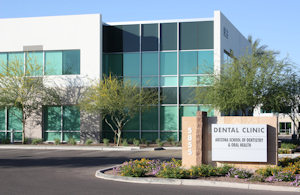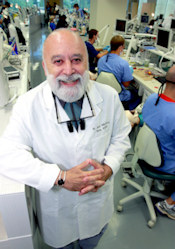The school expects more from its prospective and current students than hard work and a strong performance in the classroom and lab, Jack Dillenberg, DDS, MPH, dean of the dental school, told DrBicuspid.com.

A.T. Still University's Arizona School of Dentistry & Oral Health was founded in 2003 in Mesa, AZ.
"Once you get above the minimum GPA requirement, the main criteria we consider are community service and volunteerism," he said. "The students who come to our school have, on average, 700 hours of community service, an extraordinary number."
That commitment to volunteerism, in addition to the host of other responsibilities an average aspiring dentist has, isn't keeping applicants away, he added.
"We have a very high applicant pool -- 3,200 applicants for 76 spots last year, the highest number of applicants per seat of any school in the U.S.," Dr. Dillenberg said.
The school is directly addressing access-to-care problems through a close partnership with the federal community health center network. More than a quarter of the five graduating classes work or have worked at U.S. community health clinics.
"We have a hometown program whereby if an applicant has a letter of recommendation from a community health center, they automatically get an interview," Dr. Dillenberg explained. "That puts them pretty far ahead, since we interview about 400."
William Woods, DDS, a professor at the School of Dentistry and Oral Health, used to serve on the admissions committee at A.T. Still.
"We're looking for students who have a sense maturity, a sense of awareness about where they fit into the culture," he explained. "We're not necessarily looking for a student who wants to come to Arizona because his or her first priority is playing golf. We want people to enjoy their lives, but when you tend to put other people first, and you treat them with care and respect, then all the other tangibles of life will come to you."
Real-world experiences
That approach caught the attention of Brian Banks, DDS, a former Major League Baseball player and A.T. Still graduate who is now doing his residency in pediatric dentistry at Primary Children's Medical Center in Salt Lake City. Impressed by the school's mission to be a public health institution with a focus on community outreach, the 40-year-old former Florida Marlin and Milwaukee Brewer decided that A.T. Still was the right place to launch his career change.
“The students who come to our school have, on average, 700 hours of community service.”
— Jack Dillenberg, DDS, MPH, dean,
Arizona School of Dentistry &
Oral Health
"I got in because I wanted to help people," Dr. Banks said. "This seemed like the best way to do it."
The rotations of third- and fourth-year students are completed at public health centers and hospitals serving populations that need care the most.
"We don't spend 100% of our time in the dental clinic," Dr. Banks said. "We'll spend four weeks out in the community health center and four weeks in our clinic."
Instead of a small number of patients treated in the dental clinic, students may see as many as 10 to 15 in a single day, something Banks sees tremendous value in.
"It opens up experiences of being in a real-world setting where we're running the show, getting the opportunity to work with an assistant," he explained. "It's a two-way street: It benefits us as students who are learning to get our speed up, while at the same time we're going into homeless shelters and community health centers where we can make a difference for people who have really limited access to care."
Those experiences are having an impact on the choices students make after graduation, Dr. Dillenberg noted.
"We've graduated five classes of dental students," he said. "Of those, across the board, 26% have worked at or are working at community clinics in the U.S. Before our school started, the highest number was 8% to 9%."
Once they begin their residencies -- of 59 graduates, 38 got into programs of their choice last year, Dr. Dillenberg noted -- that field experience gives them an edge when settling into their new roles, according to Dr. Woods.
"There was one student who went to a clinic in Colorado and was able to complete 100 root canals in his rotations," he said. "That was part of his inspiration to become a root canal specialist."
The example highlights the opportunity that many students take to find their niche. "They can steer their rotations toward their interests," Dr. Woods explained. "They get a lot of experience, and it lets them know if it's something they really want to do."
Dr. Banks found his calling during a dental mission where he, five classmates, and some faculty members went to Clinica Betel in Atoyac del Álvarez, Mexico.
"That was a situation where we got to not only work with dentists but surgeons who were able to take care of kids down there stricken with cleft palate and cleft lip," Dr. Banks said. One family in particular that had traveled 18 hours to get treatment for their son moved him, and it helped determine the next step in his new career path.
"I'm currently in a pediatric residency up here in Salt Lake City at a primary children's hospital," Dr. Banks said. "And having only been here for a month and a half now, I've already been able to exceed their expectations as far as my speed in dentistry and the things I'm comfortable doing. I think the No. 1 thing that other dental schools could and should adapt if they have the means to do it is those rotations in our fourth year."
Public health emphasis growing
A.T. Still graduates are also scoring well on the exams they must pass to enter their profession, according to Dr. Dillenberg. "For the last two years on the Western Regional Exam clinical boards, our students had a 100% passing rate," he said. "This year it was 97%."

"We want to produce a super general dentist who can go and work in a rural community, be it Alaska, Montana, or Maine."
— Jack Dillenberg, DDS, MPH, dean, Arizona School of Dentistry & Oral Health
Every graduate departs with a certificate in public health, he added.
"Next year's graduating class, at least 21 will graduate with a dual degree, a master's in public health in addition to their doctor of dental medicine degree," Dr. Dillenberg said. "I believe we produce the highest number of dual-degree graduates in the U.S."
The requirement is designed to give students an overall understanding of how public health clinics work and what the access-to-care challenges are.
"For us as oral health providers, it's important to have an understanding of what it means to put together a public health project," Dr. Banks said. "By taking those courses that allow us to get those certificates, I really thing we get an appreciation for the need that's out there in the world and how to implement plans and programs."
A.T. Still does not offer graduate programs except for orthodontics and an advanced education in general dentistry residency, according to Dr. Dillenberg.
"So our students get to do these sophisticated procedures as dental students because we want to produce a super general dentist who can go and work in a rural community, be it Alaska, Montana, or Maine," he said.
The school also incorporated an element of the University of Buffalo School of Dental Medicine, which has social workers on the floors of their clinic. Master's in social work students from Arizona State University work on the clinic floor with professional social workers who, in turn, provide referrals to major behavioral health providers in the area.
"Too often the profession has been focused on just restorative dental procedures," Dr. Dillenberg said. "We have to go beyond that and reach out to other healthcare providers in the community and make them aware that we're part of the team. That's a core value that we are all about."

